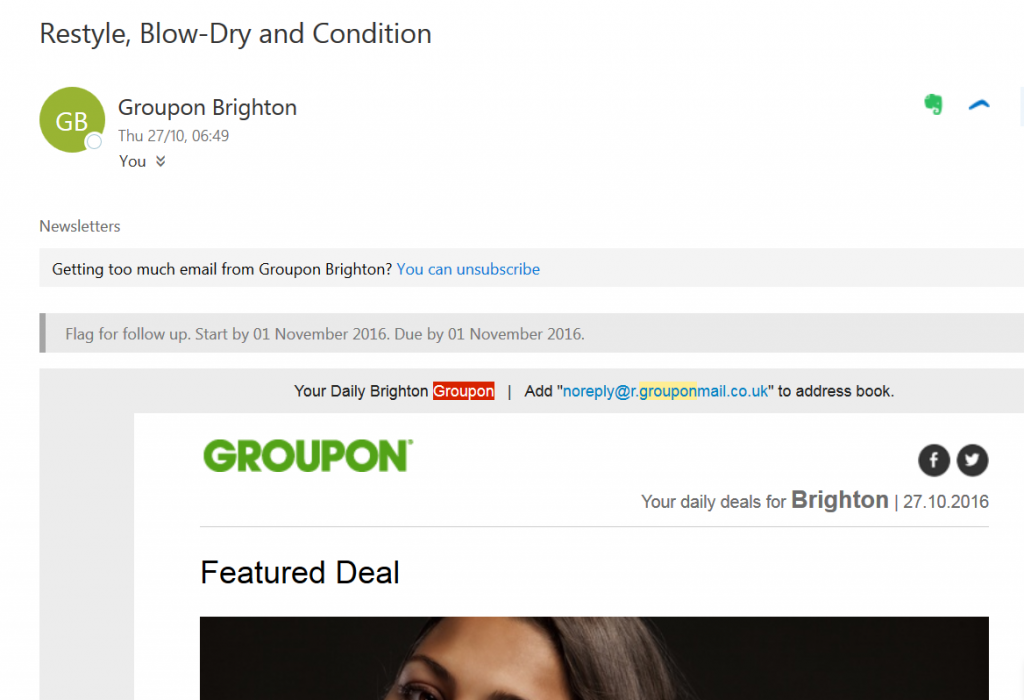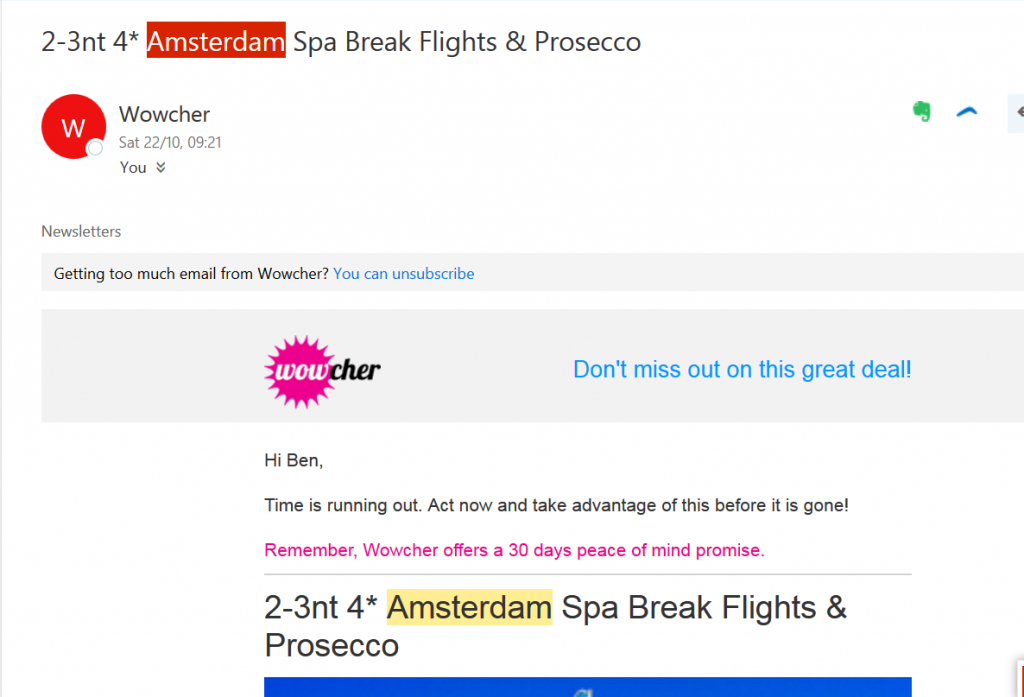I’m sure most people are aware of Groupon, but as a brief overview they offer an e-commerce marketplace which connects its subscribers with local merchant’s offerings such as local restaurants, hotels, activity days etc. Although I am also a consumer, this blog will is written by a digital marketing student. The email received below is ‘house marketing’ material and it was a weekly selection of the available deals at Groupon. This blog will explore some of the important concepts of email marketing and critique the effectiveness of Groupon’s email based on these concepts.
Subject line
I guess it makes sense to start with thinking about the first engagement I had with the email: the subject line “Restyle, Blow-Dry and Condition”. Oops, not a great start when you are targeting a twenty-something male with short hair! Ellis-Chadwick & Doherty (2012) highlight that the content of subject line is critical for grabbing attention, clearly Groupon got this very wrong in this instance which meant I was unlikely to open the email and view the other deals that may have been more suited. It might have been more useful to use a subject line that was more generic such as “Today’s deals in Brighton” until they built up a better personal profile.
Design
A positive design factor in the Groupon email was the way in which it made the “links look like links”. The links were clearly in bold and you could use the image relevant to the deal you wish to select to navigate the link for more information. The option to unsubscribe is very clear at the top of the email and it offers an easy to follow link. It is extremely important to provide the opportunity to unsubscribe and to make this clear and simple. This is because if it is not customers may mark the email as ‘spam’ which can affect future deliverability. More information can be found on this along with other important design factors here: https://emailmarketing.comm100.com/email-marketing-ebook/design-emails.aspx.
Images/ branding
Ellis-Chadwick & Doherty. (2012) suggest that pictures help engage the readers and sustain attention in marketing emails. Groupon effectively displayed enticing images of the available experiences, these pictures were very clear and a good size. Another effective part of the imaging in the email was that lots of small images were used, as opposed to one big image which can often have issues with reaching the customer. More information can be found on this here https://emailmarketing.comm100.com/email-marketing-ebook/email-images.aspx. Ellis-Chadwick & Doherty. (2012) cite the importance of positioning the brand logo prominently in marketing emails in which best practice is on the top left. Groupon’s logo was clearly located on the top left of the email so I could immediately recognise the brand.
Personalisation
The email was personalised to an extent, the deals that were offered were focused geographically to my location in Brighton. However, there was no personalisation based on my name which is useful to personalise an email and used in similar emails addressed to me by Wowcher, once of Groupons main competitors (screenshot below). Furthermore, Godin (1999) discusses the limited attention of the audience in email marketing. The first deal that Groupon provided in the email was highly irrelevant as mentioned above. Linking this to the limited attention of the audience, it is unlikely I would continue to read the email which demonstrates the importance of providing relevant content and displaying it at the forefront of the email.
Call to action
Bonini (2013) suggests that calls-to actions are extremely critical components of effective lead generation. Groupon’s call to actions are very easy to follow, you simply click on the picture of the deal you are interested in to find out more information. They also include the original price and discount which might be useful to entice customers. However, Groupon do not create a sense of urgency on the customer. Wowcher, on the other hand often send emails to me which provide a countdown until the deal runs out which effectively creates urgency, an example of this is displayed in the screenshot above. More information on creating urgency and other techniques for an effective call to action can be found here: https://www.impactbnd.com/blog/design-tips-for-creating-calls-to-action-that-pop-off-the-page.
Key lessons learned:
- Gain attention with an enticing subject line and make sure it links to the email content!
- Personalisation- make email marketing as personalised as possible- however only personalise on information you know to be accurate, don’t guess!
- Call to action- use an enticing call to action that will create urgency on the customer!
Here are a couple of other articles which are slightly more posititve and speak about the success of Groupon’s marketing:
- http://www.huffingtonpost.co.uk/preetam-kaushik/groupon-email-marketing-strategies_b_2391524.html
- http://marketingland.com/best-practice-pros-groupon-manages-email-programs-108798
Ok, so clearly Groupon’s email marketing has demonstrated high success rates as mentioned in the above articles, however my experience shows there is room for improvement! I hope you have enjoyed this post, maybe you have had similar experiences from companies in relation to email marketing? If so, or if you have anything to add I would love to hear from you in the comments section!
References
Bonini, J. (2013) Design Tips for Creating Calls-to-Action that Pop Off the Page [online] https://www.impactbnd.com/blog/design-tips-for-creating-calls-to-action-that-pop-off-the-page [accessed 27 October 2016]
Ellis-Chadwick, F., & Doherty, N. F. (2012). Web advertising: The role of e-mail marketing. Journal of Business Research, 65(6), 843-848.
Godin, S. (1999). Permission marketing: Turning strangers into friends and friends into customers. Simon & Schuster


